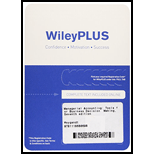
CURRENT DESIGNS
Current Designs faces a number of important decisions that require incremental analysis. Consider each of the following situations independently.
Situation 1
Recently. Mike Cichanowski, owner and CEO of Current Designs, received a phone call from the president of a brewing company. He was calling to inquire about the possibility of Current Designs producing “floating coolers” for a promotion his company was planning. These coolers resemble a kayak but are about one-third the size. They are used to float food and beverages while paddling down the river on a weekend leisure trip. The company would be interested in purchasing 100 coolers for the upcoming summer. It is willing to pay $250 per cooler. The brewing company would pick up the coolers upon completion of the order.
Mike met with Diane Buswell, controller, to identify how much it would cost Current Designs to produce the coolers. After careful analysis, the following costs were identified.
| Direct materials | $80/unit |
| Direct labor | $60/unit |
| Variable |
$20/unit |
| Fixed overhead | $1,000 |
Current Designs would be able to modify an existing mold to produce the coolers. The cost of these modifications would be approximately $2,000.
Instructions
(a) Prepare an incremental analysis to determine whether Current Designs should accept this special order to produce the coolers.
(b) Discuss additional factors that Mike and Diane should consider if Current Designs is currently operating at full capacity.
Situation 2
Current Designs is always working to identify ways to increase efficiency while becoming more environmentally conscious. During a recent brainstorming session, one employee suggested to Diane Buswell, controller, that the company should consider replacing the current rotomold oven as a way to realize savings from reduced energy consumption. The oven operates on natural gas, using 17,000 therms of natural gas for an entire year. A new, energy-efficient rotomold oven would operate on 15,000 therms of natural gas for an entire year. After seeking out price quotes from a few suppliers, Diane determined that it would cost approximately $250,000 to purchase a new, energy-efficient rotomold oven. She determines that the expected useful life of the new oven would be 10 years, and it would have no salvage value at the end of its useful life. Current Designs would be able to sell the current oven for $ 10,000.
Instructions
(a) Prepare an incremental analysis to determine if Current Designs should purchase the new rotomold oven, assuming that the average price for natural gas over the next 10 years will be $0.65 per therm.
Want to see the full answer?
Check out a sample textbook solution
Chapter 7 Solutions
Managerial Accounting: Tools For Business Decision Making, Seventh Edition Wileyplus Card
- What was her capital gains yield? General accountingarrow_forwardL.L. Bean operates two factories that produce its popular Bean boots (also known as "duck boots") in its home state of Maine. Since L.L. Bean prides itself on manufacturing its boots in Maine and not outsourcing, backorders for its boots can be high. In 2014, L.L. Bean sold about 450,000 pairs of the boots. At one point during 2014, it had a backorder level of about 100,000 pairs of boots. L.L. Bean can manufacture about 2,200 pairs of its duck boots each day with its factories running 24/7. In 2015, L.L. Bean expects to sell more than 500,000 pairs of its duck boots. As of late November 2015, the backorder quantity for Bean Boots was estimated to be about 50,000 pairs. Question:arrow_forwardWhat was her capital gains yield?arrow_forward
- Principles of Accounting Volume 2AccountingISBN:9781947172609Author:OpenStaxPublisher:OpenStax College
